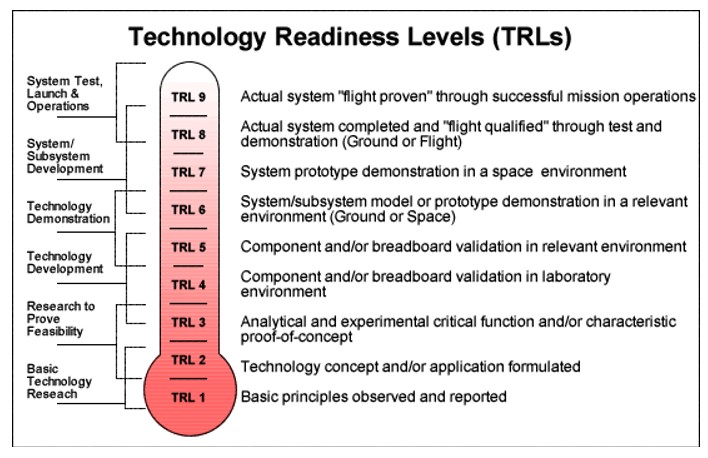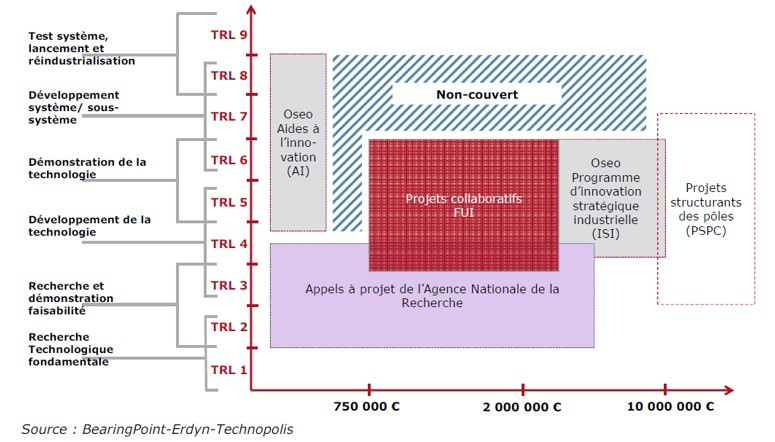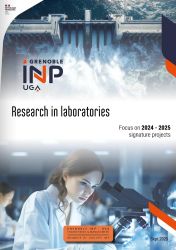article written by Wahiba Robert
TRL (Technology Readiness Level) is a measurement system used to assess a technology maturity level. First developed and used by NASA in the 1970s and 1980s, TRLs are now widely used.
The scale has 9 maturity levels (from 1 - low - to 9 - high); the higher the level, the more secure the technology is for market uptake as a product (e.g., a software application) or as a component to be integrated into a system. Here is an overview of the scale; a detailed view is provided below.

TRLs help in making decisions about technology development and transfer.
The benefits?
• Provide a common understanding of the state of a technology,
• Enable risk management,
• Manage the time, cost and resources required to make the technology applicable.
Typically, innovations from our research laboratories fall into a level between 1 and 4. Collaboration with companies (for example, in the context of CIFRE theses) is conducive to higher TRLs because of access to the real environment. Without these close partnerships, the technology often needs to be worked on to increase its TRL via so-called pre-maturation/maturation schemes to enable the technology to be transferred to the socio-economic world.
Today, access to most funding windows (research, innovation and technology transfer) depends on the TRL level of the technology that is the subject of the project presented for funding.
Here is an example:

Source: BearingPoint - Erdyn-Technopolis, juin 2012: Study on competitiveness clutsters assessement | Chapter 4: funding clusters’ R&D projects
DRIVE's research and development project managers are there to direct you to the most appropriate offices for your project.
Technology Readiness Level (TRL) scale - Technology maturity levels
| TRL | Description |
| 1. The basic principles have been observed and described | This is the lowest level of maturity of a technology. Scientific research military applications of are beginning to be assessed, for example in the form of publications analysing the fundamental characteristics of the technology |
| 2. Concepts of use and/or proposals for applications have been formulated at the beginning of the invention phase. | From the observation of the basic principles, it becomes possible to envisage practical applications. These applications remain potential. There is no proof or detailed analysis to confirm them. We are still at the stage of paper studies. |
| 3. First stage of analytical or experimental demonstration of critical functions and/or certain characteristics. | Initiation of analytical studies and laboratory work on the validation of certain building blocks of the technology in order to validate the prediction studies in practice. |
| 4. Validation in a laboratory environment of elementary building blocks and/or basic subsystems | The basic components of the technology have been integrated, but in a form that is relatively "unrepresentative" of a possible system, for example in the form of a laboratory "mock-up". |
| 5. Validation in a representative environment of elementary bricks and/or subsystems. | The representativeness of the subsystems increases significantly. The elementary building blocks are integrated into a complete assembly allowing the technology to be tested in a realistic simulated environment, for example in the form of a "highly representative" laboratory integration. |
| 6. Demonstration in a representative environment of models or prototypes of a system or sub-system. | A representative model or prototype system is tested in a representative environment, much more complete than what was tested in step 5, and this represents a key step in demonstrating the maturity of a technology, such as testing a prototype in a laboratory with very accurate environmental conditions, or operational conditions of use. |
| 7. Demonstration of a prototype system in an operational environment. | Demonstration of a prototype system that is consistent with, or very close to, the operational system. This represents a significant progression from step 6, with the demonstration of a real prototype in an operational environment, such as a vehicle or an airborne platform, e.g., a test bed aircraft. Information will be gathered at this stage to obtain the supportability of this technology. |
| 8. The actual fully realised system is qualified by testing and demonstration. | The technology has been proven to work, in its final form, and under the expected conditions of use. This stage is in most cases the end of the demonstration, e.g., testing and evaluation of the system within the planned weapon system to see if it meets the required specifications, including in-service support. |
| 9. The system is qualified, following its employment in successful operational missions. | The stage of application of the technology in its final form, and under representative mission conditions, such as those that may be encountered in operational testing and evaluation, and reliability testing, including for example employment in operational mission conditions. |
Source: http://www.agence-nationale-recherche.fr/fileadmin/aap/2014/aap-astrid-m-2014.pdf




